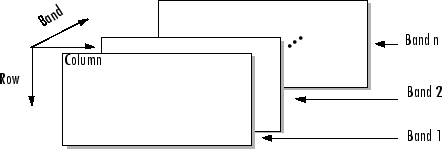multibandread
从二进制文件读取波段交错文件
语法
X = multibandread(filename,size,precision,offset,interleave,byteorder)
X = multibandread(...,subset1,subset2,subset3)
说明
X = multibandread(filename,size,precision,offset,interleave,byteorder) 从二进制文件 filename 读取波段顺序 (BSQ)、波段按行交错 (BIL) 或波段按像素交错 (BIP) 数据。filename 输入指定为字符向量或字符串标量。该函数将波段>定义为三维数组的第三个维度,如下图所示。

您可以使用 multibandread 的参数来指定读取操作的各个方面,例如读取哪些波段。有关详细信息,请参阅参数。
X 是二维数组(如果只读取一个波段);否则是三维数组。默认情况下,X 返回为 double 数据类型的数组。使用 precision 参数可将数据映射到不同数据类型。
X = multibandread(...,subset1,subset2,subset3) 读取文件中数据的子集。您最多可以使用三个子集设置参数指定沿行、列和波段维度的数据子集。有关详细信息,请参阅子集设置参数。
注意
除了 BSQ、BIL 和 BIP 文件,还可以使用 TIFF 文件格式存储多波段图像。在这种情况下,可使用 imread 函数导入数据。
参数
该表格介绍了 multibandread 所接受的参量。
参量 | 描述 |
|---|---|
| 字符向量或字符串标量,包含要读取的文件的名称。 |
| 三元素整数向量包含
如果全部读取,那么它们就是数据的维度。 |
| 指定要读取的数据格式的字符向量或字符串标量,例如 注意:还可以使用 |
| 指定文件中第一个数据元素位置的标量(从 0 开始计算)。该值表示文件起始处到数据起始处的字节数。 |
| 存储数据的格式,指定为下列值之一:
有关这些交错方法的详细信息,请参阅 |
| 指定数据存储字节顺序(机器格式)的字符向量或字符串标量,例如:
关于支持格式的完整列表,请参阅 |
子集设置参数
最多可以指定三个子集设置参数。每个取子集参数都是一个三元素元胞数组 {,其中dim,method,index}
参数 | 描述 |
|---|---|
| 取子集时所沿的维度。指定为下列任意值之一:
|
| 子集设置方法。指定为下列值之一:
如果忽略此子集元胞数组元素, |
| 如果 如果 |
示例
版本历史记录
在 R2006a 之前推出
另请参阅
fread | fwrite | imread | memmapfile | multibandwrite